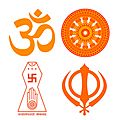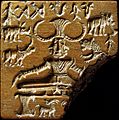Indian religions facts for kids
Indian religions are a group of beliefs and practices that started in the country of India and the areas around it. A key idea shared by many of these religions is called Dharma. It's like a path of right living or a way to understand the natural order of the universe. These religions have shaped the culture, art, and history of India for thousands of years.
Contents
Main Indian Religions
Many important religions began in India. Here are some of the main ones:
Hinduism: A Diverse Tradition
Hinduism is one of the oldest religions in the world. It has many different traditions, beliefs, and ways of worship. Hindus believe in many gods and goddesses, who are often seen as different forms of one main spiritual power called Brahman.
Hindus believe in reincarnation, which means that after a person dies, their soul is reborn into a new body. The kind of life they have in their next life depends on their actions in this life, a concept called karma. Many Hindus also believe in moksha, which is the idea of breaking free from the cycle of rebirth.
Hinduism has many holy books, like the Vedas and the Upanishads. Temples are important places for worship, and festivals like Diwali (the festival of lights) and Holi (the festival of colors) are celebrated with great joy.
Buddhism: The Path to Enlightenment
Buddhism began with Siddhartha Gautama, who became known as the Buddha (meaning "the awakened one"). He lived in ancient India around 2,500 years ago. The Buddha taught that suffering is a part of life, but there is a way to end it by following the Four Noble Truths and the Eightfold Path.
Buddhists aim to reach nirvana, a state of perfect peace and freedom from suffering. They believe in karma and reincarnation, similar to Hinduism. Meditation is a very important practice in Buddhism, helping people to calm their minds and gain wisdom.
Buddhism spread from India to many other parts of Asia, like China, Japan, and Thailand. Monks and nuns live in monasteries, dedicating their lives to studying and practicing the Buddha's teachings.
Jainism: Non-Violence Above All
Jainism is another ancient Indian religion. It was founded by Mahavira, who lived around the same time as the Buddha. The most important principle in Jainism is ahimsa, or non-violence, towards all living things. Jains believe that every living being, from humans to tiny insects, has a soul.
Jains follow strict rules to avoid harming any creature. Many Jains are vegetarians or vegans. They also practice self-control and try to live simple lives. The goal in Jainism is to reach moksha, which means freeing the soul from the cycle of rebirth and achieving a state of pure consciousness.
Jain temples are often beautifully carved, and their festivals celebrate important events in the lives of their spiritual teachers, called Tirthankaras.
Sikhism: One God, Equality for All
Sikhism is a newer religion compared to Hinduism, Buddhism, and Jainism. It was started by Guru Nanak in the 15th century in the Punjab region of India. Sikhs believe in one God, called Waheguru. They believe that all people are equal, regardless of their background or gender.
Sikhs follow the teachings of their ten Gurus, which are collected in their holy book, the Guru Granth Sahib. This book is treated with great respect and is considered a living Guru. Sikhs often wear a turban and carry five articles of faith, known as the Five Ks, which remind them of their beliefs.
The main place of worship for Sikhs is called a gurdwara. The most famous gurdwara is the Golden Temple in Amritsar, India. Sikhs are known for their community service and for sharing food with everyone in their gurdwaras.
Images for kids
-
"Priest King" of Indus Valley civilisation
-
The Golden Temple of Mahalakshmi at Vellore.
-
An aerial view of the Meenakshi Temple from the top of the southern gopuram, looking north. The temple was rebuilt by the Vijayanagar Empire.
-
Harmandir Sahib (The Golden Temple) is culturally the most significant place of worship for the Sikhs.
-
Mahamagam Festival is a holy festival celebrated once in twelve years in Tamil Nadu. Mahamagam Festival, which is held at Kumbakonam. This festival is also called as Kumbamela of South.
-
The largest religious gathering ever held on Earth, the 2001 Maha Kumbh Mela held in Prayag attracted around 70 million Hindus from around the world.
-
Map showing the prevalence of Abrahamic (pink) and Indian religions (yellow) in each country
-
A devotee facing the Ganga, reading a stack of holy books ("Chalisa" of various god) at the Kumbh Mela














